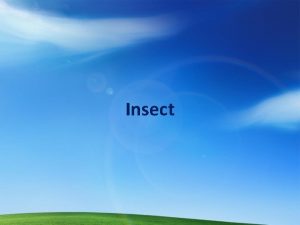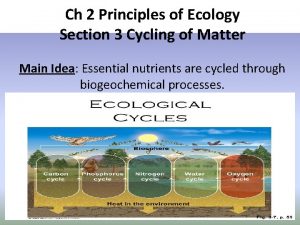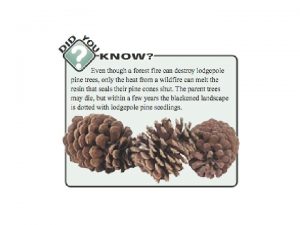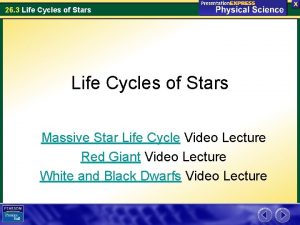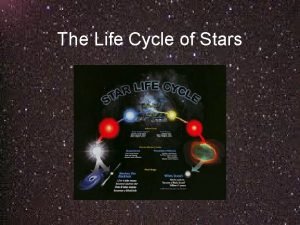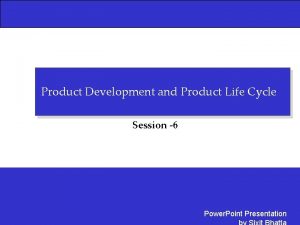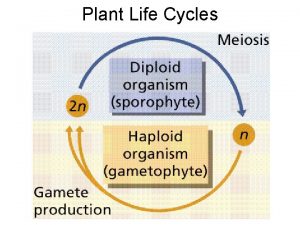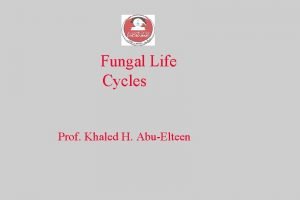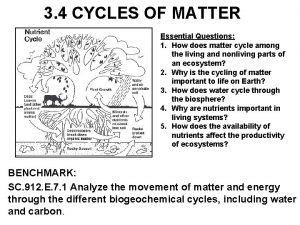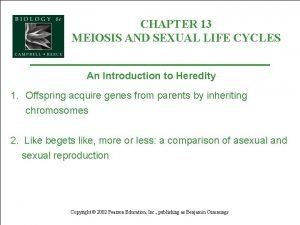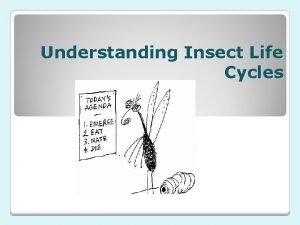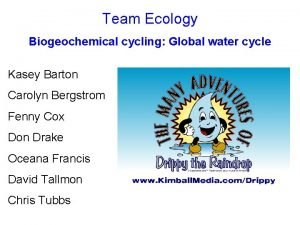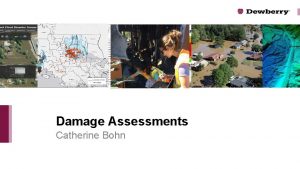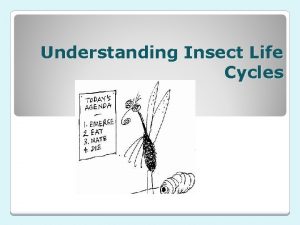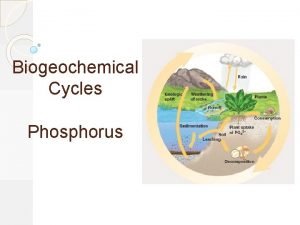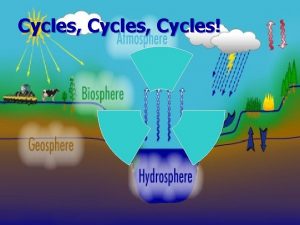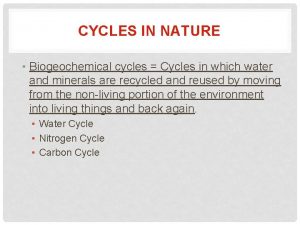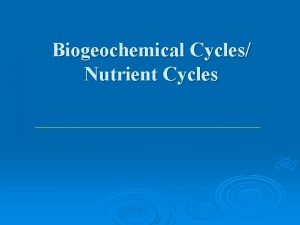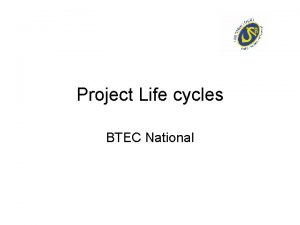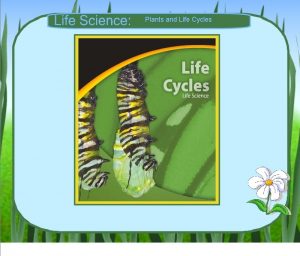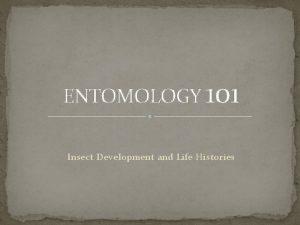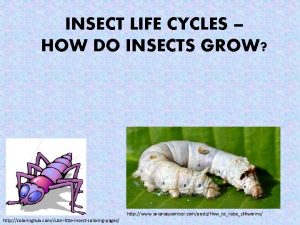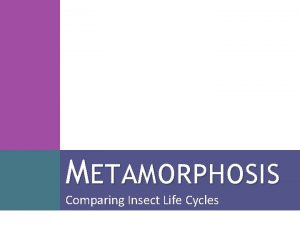Insect Outline Insect life cycles damage Key insect




















- Slides: 20

Insect

Outline • Insect life cycles & damage • Key insect pest groups • Principles of integrated pest management (IPM)

Why knowledge of insect life cycles is essential • Stage(s) causing injury • Prediction of damage • Effects of mortality factors • Timing of control operations

Insect development Hemimetabolous (incomplete metamorphosis) Adult Nymph (instars) • Green vegetable bug Moult Eggs Orders: • Hemiptera/Homoptera • Orthoptera

Insect development Holometabolous (complete metamorphosis) • NZ grass grub Pupa Adult L 3 Orders: • Coleoptera Larva (instars) • Lepidoptera • Hymenoptera L 2 Egg Moult L 1 • Diptera

How do insects cause injury? • Direct feeding - leaves (caterpillars) - stems (Argentine stem weevil) - roots (grass grub) - flowers & seeds (aphids, mirids) • transmission of plant pathogens (aphids) • contamination (aphids & honeydew) • others (e. g. , egg laying, webbing)

Injury caused by insects Feeding injury Transmission of pathogens Effect on plant physiology Honeydew Ovipositor injury Frass

Key principle of pest control Driven by economics

Pest threshold levels Generalised concept of pest threshold levels AT = action threshold EIL = economic injury level Control action

Tools for monitoring insects Direct methods (absolute #s) – Soil pests – soil cores, spade squares, quadrats – Plant pests – leaf, stem, fruit samples; timed counts, suction samplers Indirect methods (relative #s) sticky traps, pheromone traps, pitfall traps, band traps, beating trays, sweep nets

Aphids Species Cereal crops: cereal aphid, grain aphid, rose grain aphid, others Potato crops Potato aphid, green peach aphid, others Brassicas - grey cabbage aphid, green peach aphid Biological features • spring, autumn flights • rapid colonisation • rapid asexual reproduction • many generations per year • vector virus diseases

Source: Plant & Food Research – Aphid Watch website – www. aphidwatch. com

Tomato/potato psyllid Adult psyllid Psyllid yellows symptoms Zebra chip symptoms Biological features • Recent invader • Attacks tomato, potato • Causes ‘psyllid yellows’ & ‘zebra chip’ (Liberibacter) • Adults 3 -4 mm, highly mobile • Scale-like nymphs • 4 -7 generations/year

Grubs Species • common grass grub • Tasmanian grass grub • Black beetle • Native scarabs Biological features • larval damage autumn, early winter • 1 generation/year • slow build up • most damaging to crops out of pasture

Weevils Species • Argentine stem weevil • Clover root weevil • Whitefringed weevil • Black vine weevil • Fullers rose weevil • Others Biological features • legless larvae burrow in tillers, roots, nodules • most damaging to newly sown crops, pasture • 1 -3 generations per year

Caterpillars Species • Leafrollers • Diamondback moth • Loopers • Cutworms • Armyworms • Porina • Others Biological features • peak egg laying during spring, early summer • larvae feed on foliage • most damaging to young plant growth • 1 -6 generations per year

Springtails Species several species Biological features • small, soft-bodied, wingless insects • nymphs and adults feed on surface of leaves • most damaging in spring and autumn • several generations/year

Thrips • New Zealand flower thrips • Western flower thrips • Onion thrips • Other species Biological features • Reproduce and disperse rapidly • Severe damage to young foliage • Potential vectors of plant diseases • Some species resistant to chemicals Onion thrips and damage

Key principles of integrated pest management (IPM) The IPM approach Key rules An economically • the earlier the pest is viable strategy for recognised or pest management that anticipated, the more exploits a range of control options compatible control • use a range of methods. controls, at different time - chemicals are the last resort.

Insecticides Key classes Action Carbamate Organophosphate Pyrethroids Neonicotinoids Spinosyns Insect growth regulators Microbial insectcides nerve poison, contact systemic nerve poison, contact, systemic, fumigant nerve poisons, contact nerve poison, contact, systemic nerve poison, contact disruption of growth, development various actions Mo. A 1 A 1 B 3 A 4 a 5 15 -18 Some issues: • Resistance and resistance management • Withholding periods and residues (MRLs, international markets) • Product availability (registration of new, de-registration of older) • Cost
 Hemimetabolous metamorphosis
Hemimetabolous metamorphosis Lesson 2 cycles of matter answer key
Lesson 2 cycles of matter answer key Practice geochemical cycles answer key
Practice geochemical cycles answer key Cycle.of life
Cycle.of life Bill nye life cycles
Bill nye life cycles Life cycles of a bird
Life cycles of a bird Section 26.3 life cycles of stars
Section 26.3 life cycles of stars Protostar phase
Protostar phase Fadlife
Fadlife Plant life cycles and alternation of generations
Plant life cycles and alternation of generations Sac fungi life cycle
Sac fungi life cycle Chapter 13: meiosis and sexual life cycles
Chapter 13: meiosis and sexual life cycles Matter cycle
Matter cycle Chapter 13 meiosis and sexual life cycles
Chapter 13 meiosis and sexual life cycles Dermaptera metamorphosis
Dermaptera metamorphosis Citation sandwich example
Citation sandwich example Business model canvas key partners
Business model canvas key partners Business model canvas tripadvisor
Business model canvas tripadvisor Mandarin cycles
Mandarin cycles Importance of water cycle
Importance of water cycle Pdsa cycle nursing
Pdsa cycle nursing
